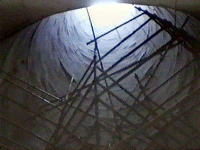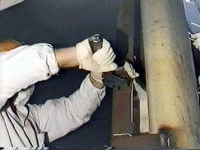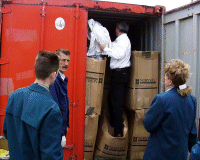Chornobyl Report
A biweekly update of Chornobyl support activities for May 22, 1998
Stack repairs surpass 50 percent complete
 Upward view from inside the base of the vent stack. |
The finished repairs include replacement of one horizontal brace that was completely torn away in the accident, replacement of six diagonal braces that were seriously damaged, and the welding of "strongback" supports over three structurally significant dents in vertical braces. The radiation doses received to date by workers doing the repairs were substantially less than preliminary estimates, due to worker training on a full-scale mock-up of part of the bracing framework.
 Worker bolts sections of vertical bracing at the foundation of the vent stack. The vertical deviation of the damaged foundation support can be seen here. |
The remaining repairs -- to strengthen the stack foundation located inside the building, replace additional damaged braces, and strengthen dented braces -- will be completed by July. This work will return the stack and its bracing to full design strength.
The project is funded jointly by the U.S. Department of Energy, Canada, and Ukraine. Structural analysis, repair design, contracting, and project management are performed by Ukrainian organizations, and are on schedule and within budget.
Breakthrough in customs delay
 Workers unload long-awaited safety equipment. |
Among the first equipment released are components of a million-dollar neutron monitoring system designed and assembled at PNNL. The system will be used to monitor and document radiological conditions of the nuclear-fuel-containing masses located in the lower elevations of the Shelter. Also released
 Equipment moves one step closer to Chornobyl site. |
It's official!
The European Bank for Reconstruction and Development (EBRD) on May 13 announced that agreements formalizing the contract for the consultant to the Chornobyl Shelter Project Management Unit (PMU) were signed on May 11 by Ukraine's Minister of Energy and representatives of the Bechtel National, Electricite' de France, and Battelle team. The official signing occurred in Kyiv, Ukraine, in conjunction with EBRD's annual meeting.
The two-year, $20 million contract is for management of work to provide safety improvements to the structure that encloses the remains of Chornobyl Unit 4. Eighteen countries have pledged $337 million toward the total $760 million cost for the Shelter safety improvement work over the next eight years. Ukraine has committed $50 million over the life of the project. Additional funding will be needed to complete the project.
As project management consultant, the Bechtel-EdF-Battelle team will work with Chornobyl NPP management and staff to provide program management leadership on technical projects, operations and business programs, licensing, and regulatory strategies. "Through collaborative efforts, we'll work to convert the existing Shelter and the remnants of the destroyed reactor into a stable, confined, and environmentally safe condition," said Dennis Kreid, manager of the Chornobyl Shelter Project for Battelle.
Bechtel, EdF, and Battelle are mobilizing to Ukraine a core team with representatives from each of the three firms to establish an on-site project management base and begin the task of implementing the work outlined in the Shelter Implementation Plan (SIP). In addition, a separate team of experts from the PMU including Ukrainian and Consultant members has completed evaluation of Early Biddable Project (EBP) "A," which contains planning, preliminary design, and site preparations for the principal construction and stabilization tasks of the SIP. The reviews of EBPs "B," "C," and "D" will follow in close succession, with completion planned for early July.
Progress continues on key Chornobyl Center initiatives
The United States is involved with various initiatives at the Chornobyl Center and the Slavutych Laboratory for International Research and Technology that help to further safety improvement efforts at Chornobyl's operating Unit 3 and destroyed Unit 4. Highlights of some of the progress being made include
Securing additional participation in the National Laboratory Network from the German nuclear laboratory Gesellschaft fur Anlangen und Reaktorsicherheit mbH (GRS), and the French nuclear safety laboratory Institut de Protection et de Surete Nucleaire (IPSN). The Network is an informal group of representatives from the U.S. Department of Energy's national laboratories and the U.S. Environmental Protection Agency that shares information and ideas to assist in further developing the Chornobyl Center.
Providing Chornobyl Center management with a comprehensive list of basic nuclear science and technology reference material and major periodicals to be acquired for the Nuclear Reference Library at the Slavutych Laboratory. A list of publications available from Russia has been generated to supplement the English publications. Purchase orders for the desired publications will be placed for Slavutych Laboratory subscriptions. Furnishings for the library will be supplied as part of Brookhaven National Laboratory-led training projects.
Slavutych Laboratory officials recently signed a $50,000-per-year contract with the French firm, SGN, to provide staff, training, and informational services to the On-Site Technical Assistance (OSAT) decommissioning project. This represents one of the first international relationships, aside from those with the United States, between the Slavutych Laboratory and a private firm to perform Chornobyl safety-related work.
Chornobyl Center management is optimistic that discussions between the Ministries of Foreign Affairs in Ukraine and Italy will lead to the signing of a Memorandum of Understanding in fall 1998. The Italian government will undertake joint Chornobyl Center activities in emergency procedures, radioecology, medical consequences, and radioactive waste management.
Three meetings have been held between representatives of Japan's Nuclear Safety Research Association and Chornobyl Center Coordinating Director Valery Glygalo. Two joint projects are being considered: 1) an analysis of fuel remains in the Chornobyl Shelter, using a Japanese severe accident computer code; and 2) radioecology of the area immediately adjacent to the Exclusion Zone. Funding of these projects is expected soon.
Arrangements are being made for the 1998 conference on International Activities at Chornobyl, planned for October 13 through 16. Sponsorship to date includes the United States, Ukraine, and the United Kingdom. A preliminary announcement and call for papers are being prepared for issuance. Dr. Terry Lash, the U.S. Department of Energy's director of the Office of International Nuclear Safety to the Office of Nonproliferation and National Security, will co-chair the conference.
 Flags at the Slavutych Laboratory represent international cooperation. |
See also Chornobyl Initiatives/General Information on Chornobyl and the Biweekly Report Archive.